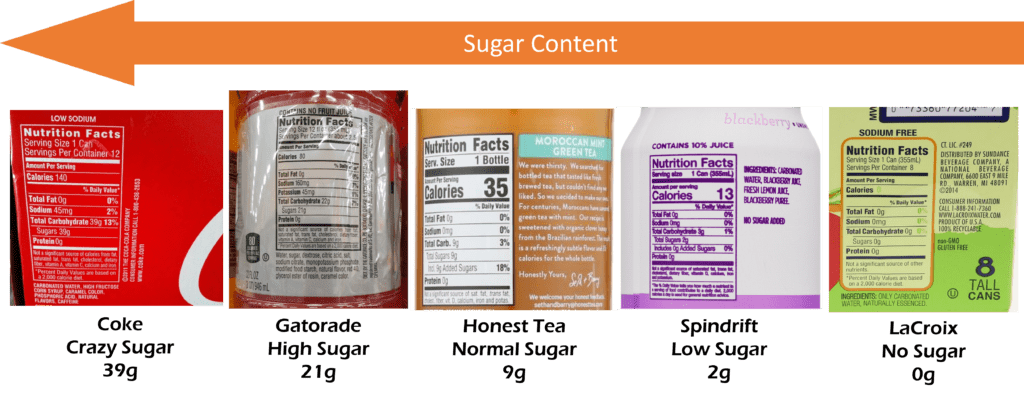Forget About Fat: The Real Killer is Sugar

Credit: Shutterstock
This weekend I had a direct experience with America’s insatiable appetite for sugar. At the same time, a study published in a prestigious medical journal just identified that we could save millions of lives if we just readjusted America’s packaged food sugar content. Let’s dig in.
My Recent Sugar Rush
This weekend, I was hanging out with my daughter for Father’s weekend and first of all, college girls can drink. In fact, I knew from the last father’s weekend two years ago to not even try to keep up. 95 pound 5 feet tall young women in college can drink 200-pound fathers into the ground. This is a physical law like gravity.
At one of the several watering holes we stopped at after the big game, I ordered the same drink that everyone was having. Now in our town of Boulder, Colorado, the fitness capital of the planet earth, they automatically know to make things with a fraction of the sugar that would normally exist in other places. However, because I had spent the last two months on a CLEAN program diet, my sugar receptors were upregulated. Meaning, this drink was so crazy sweet that I almost couldn’t drink it. How sweet was it? About 1/4 as sweet as your average Coke.
Which is my point. Our sugar taste receptors adjust to our diet. If like me, you’ve had only low concentrations of sugar for two months, orange juice is so sweet that it’s almost not edible. On the other hand, if you eat like the average American where fistfuls of sugar are hidden in various foods and consumed every day, orange juice without sugar added tastes acidic and isn’t pleasurable.
Why Sugar Kills
When I was in medical school (which was a very long time ago when Reagan was president), the big thing was how dietary fat was killing Americans. Since then we’ve learned that certain types of fat are bad (the artificial fats that allow Twinkies and McDonald’s Hamburgers to survive intact like Egyptian artifacts). However, most fats are fine. On the other hand, now we know that if we had to cut out one thing from the American diet that could save lives, it would be sugar. Why?
When you eat lots of sugar, you release gobs of insulin to push that sugar into your cells. For many of us, that excessive insulin and big swings in our blood sugar levels cause very real problems. In fact, that eats up arteries and adds dangerous pounds. The latter happens because for many, eating sugar causes an eventual drop in blood sugar which then requires more sugar intake. The resulting metabolic syndrome is the number one killer in all industrialized nations.
The New Research
Researchers at Massachusetts General Hospital just created a model to simulate and quantify the health and economic impacts of a national sugar-reduction policy (1). This partnership called the NSSRI (National Salt and Sugar Reduction Initiative) is a consortium of 100 local, state, and national health organizations. The group released draft sugar-reduction targets for packaged foods and beverages in 2018. Therefore the goal of the study was to model what would happen to both mortality and health care costs if the processed foods industry voluntarily reduced the sugar content of these foods across the board.
The paper found that cutting 20% of sugar from packaged foods and 40% from beverages could prevent 2.48 million deaths such as strokes, heart attacks, and cardiac arrests. At 10 years into the NSSRI sugar reduction policy, the U.S. could expect to save $4.28 billion USD and over the lifetime of the current adult population, the savings jump to $118.04 billion!
Readjusting Your Sugar Intake
Whether the NSSRI goes into effect or not, you can easily adjust your sugar intake. Just make a concerted effort to not eat pre-packaged foods and/or control the amount of sugar that goes into your body. Read labels! For example:

I assembled all of these labels from online searches to illustrate a point. If you’re drinking Coke right now, that’s just asking for early death, so STOP. Gatorade, in this rubric, is considered high sugar. Something like Honest Tea Morrocan Mint is considered a normal amount of sugar to find in a drink. Spindrift is low sugar at 2g. Obviously, drinks like Perrier, Pelegrino, or LaCroix have no sugar. Hence, you should be drinking no or low sugar drinks and every once in a while enjoying the normal sugar in something like Honest Tea (NOT their “Honey” product which is high sugar).
You should use these same sugar guidelines with other packaged foods as well. Anything with 5-6g of sugar or under is great. Anything with 10g or so is an every once in a while treat. Anything with 20g of sugar or more shouldn’t be eaten other than maybe once a year at a Christmas party!
As you reduce sugar intake, week over week, you’ll find that you need less and less as your taste receptors adjust. In addition, you’ll likely lose some weight as less insulin production means that fat can be burned more efficiently and your appetite will diminish. After a month or two, a sip of orange juice will taste so obnoxiously sweet, that you’ll be amazed at how little sugar our bodies need to appreciate the sensation of sweetness.
Does this Impact Your Stem Cells?
Given what we know about how type 2 diabetes and metabolic syndrome impact the health of stem cells, you should be following a low sugar diet before a stem cell procedure (2). This is something we have recommended for years.
The upshot? I’m not a big government guy, but I can say that the professors at Mass General have this one right. We could save a slew of lives and money by just readjusting the taste receptors of millions of Americans to reality. Most people would never know this happened if the reductions are a little bit each year and industry-wide. Meaning by the time these reductions are complete, everything will still taste sweet, but we’ll have far fewer early deaths!
______________________________________________
(1) Siyi Shangguan, Dariush Mozaffarian, Stephen Sy, Yujin Lee, Junxiu Liu, Parke E. Wilde, Andrea L. Sharkey, Erin A. Dowling, Matti Marklund, Shafika Abrahams-Gessel, Thomas A. Gaziano, Renata Micha. Health Impact and Cost-Effectiveness of Achieving the National Salt and Sugar Reduction Initiative Voluntary Sugar Reduction Targets in the United States: A Micro-Simulation Study. Circulation, 2021; DOI: 10.1161/CIRCULATIONAHA.121.053678
(2) Kornicka K, Houston J, Marycz K. Dysfunction of Mesenchymal Stem Cells Isolated from Metabolic Syndrome and Type 2 Diabetic Patients as Result of Oxidative Stress and Autophagy may Limit Their Potential Therapeutic Use. Stem Cell Rev Rep. 2018 Jun;14(3):337-345. doi: 10.1007/s12015-018-9809-x. PMID: 29611042; PMCID: PMC5960487.

NOTE: This blog post provides general information to help the reader better understand regenerative medicine, musculoskeletal health, and related subjects. All content provided in this blog, website, or any linked materials, including text, graphics, images, patient profiles, outcomes, and information, are not intended and should not be considered or used as a substitute for medical advice, diagnosis, or treatment. Please always consult with a professional and certified healthcare provider to discuss if a treatment is right for you.
